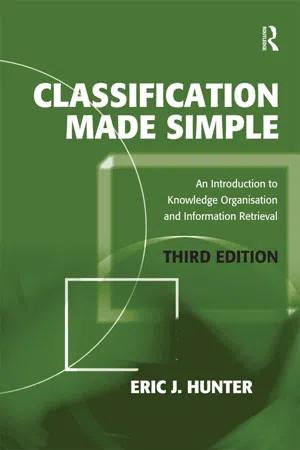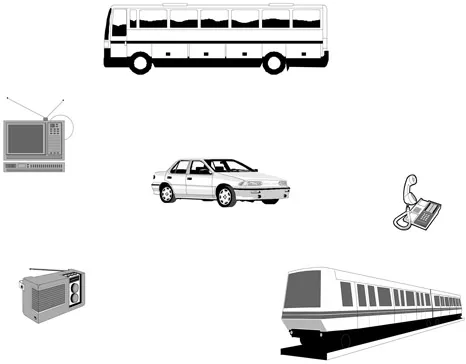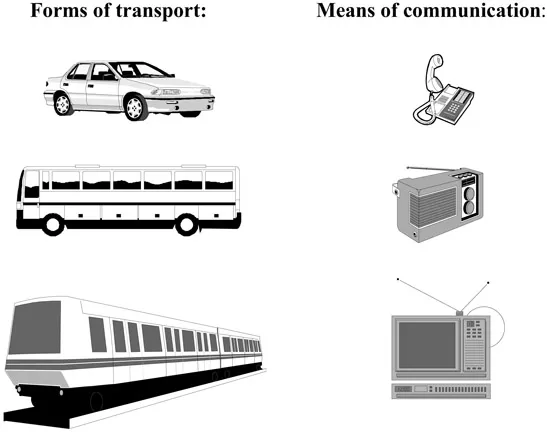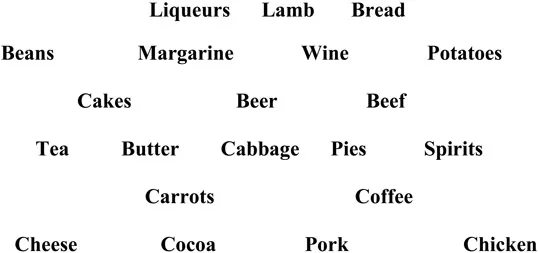
eBook - ePub
Classification Made Simple
An Introduction to Knowledge Organisation and Information Retrieval
- 176 pages
- English
- ePUB (mobile friendly)
- Available on iOS & Android
eBook - ePub
Classification Made Simple
An Introduction to Knowledge Organisation and Information Retrieval
About this book
This established textbook introduces the essentials of classification as used for information processing. The third edition takes account of developments that have taken place since the second edition was published in 2002. Classification Made Simple provides a useful gateway to more advanced works and the study of specific schemes. As an introductory text, it will be invaluable to students of information work and to anyone inside or outside the information profession who needs to understand the manner in which classification can be utilized to facilitate and enhance organisation and retrieval.
Frequently asked questions
Yes, you can cancel anytime from the Subscription tab in your account settings on the Perlego website. Your subscription will stay active until the end of your current billing period. Learn how to cancel your subscription.
At the moment all of our mobile-responsive ePub books are available to download via the app. Most of our PDFs are also available to download and we're working on making the final remaining ones downloadable now. Learn more here.
Perlego offers two plans: Essential and Complete
- Essential is ideal for learners and professionals who enjoy exploring a wide range of subjects. Access the Essential Library with 800,000+ trusted titles and best-sellers across business, personal growth, and the humanities. Includes unlimited reading time and Standard Read Aloud voice.
- Complete: Perfect for advanced learners and researchers needing full, unrestricted access. Unlock 1.4M+ books across hundreds of subjects, including academic and specialized titles. The Complete Plan also includes advanced features like Premium Read Aloud and Research Assistant.
We are an online textbook subscription service, where you can get access to an entire online library for less than the price of a single book per month. With over 1 million books across 1000+ topics, we’ve got you covered! Learn more here.
Look out for the read-aloud symbol on your next book to see if you can listen to it. The read-aloud tool reads text aloud for you, highlighting the text as it is being read. You can pause it, speed it up and slow it down. Learn more here.
Yes! You can use the Perlego app on both iOS or Android devices to read anytime, anywhere — even offline. Perfect for commutes or when you’re on the go.
Please note we cannot support devices running on iOS 13 and Android 7 or earlier. Learn more about using the app.
Please note we cannot support devices running on iOS 13 and Android 7 or earlier. Learn more about using the app.
Yes, you can access Classification Made Simple by Eric J. Hunter in PDF and/or ePUB format, as well as other popular books in Languages & Linguistics & Library & Information Science. We have over one million books available in our catalogue for you to explore.
Information
Edition
3Subtopic
Library & Information Science1
What is Classification?
We all have to process information. Consider the following images:

Could you tell the difference? Of course you could; you would be in a certain amount of trouble if you couldn’t. This means that you are capable of processing information and, in order to do that, you must make use of classification.
In essence the process of classification simply means the grouping together of like things according to some common quality or characteristic. This automatically implies the separation of the unlike as in the above example.
As human beings, we are able to recognise a member of a particular class because it displays certain characteristics common to that class but not to others. Examine the following collection:

From observation, one is able to immediately identify like entities:

In making the above distinction and grouping the things as shown, a process of classification has been carried out in that like things have been grouped together and unlike things separated. It is essential for a person to be able to think logically in this way and to make such distinctions – classification ‘lies at the base of every well-managed life and occupation’ (Maltby, 1975). Otherwise one would be sitting on the television set waiting to be transported to work! Beam me up, Scotty!
Wherever one looks, examples of the use of classification can be found. Take, for instance, the case of Harrison Ford, alias Indiana Jones. Ford hasn’t always been a film actor. In the early seventies he became seriously dissatisfied with the sameness and blandness of the work that he was being offered so he gave up acting and became a carpenter instead (Glock, 2008). Apparently he became a very good carpenter and examples of his work are to be found to this day in many a home in Beverly Hills (Norman, 1997). When Ford was whittling wood, he kept all of his carpentry tools laid out in order of type and size right though his entire workshop (Courtenay, 1994). He realised that this would make his work that much easier. By putting all of his cutting tools together, Ford would separate them immediately from his drilling tools and from his smoothing tools. Clearly, he recognises the enormous value of classification.
What would Ford have to say do you think, if he visited his local supermarket and found the goods arranged as shown below.

It would be chaos! Shopping would be very difficult and time consuming.
No doubt Ford would much prefer, as we all would, to find similar products shelved together and differing products separated:

It is now quite simple to process the information that we are being given. Classification makes shopping, and indeed all aspects of our lives, very much easier.
References
Courtenay, Chris (1994), ‘Indiana Jones and His Homely Crusade’, Daily Mail Weekend (16 July), pp. 4–5.
Glock, Allison (2008), ‘Blade Runner’, Telegraph Magazine (10 May), pp.46–50.,
Maltby, Arthur (1975), Sayers’ Manual of Classification for Librarians, 5th ed., Deutsch, London, p. 15.
Norman, Barry (1997), ‘Why Ford Sticks To What He Does Best’, RadioTimes (12–18 April), p. 46.
2
Classification in an Information System
Specifically – from the point of view of this book – classificatory techniques may be applied in an information system in order to facilitate access, organisation, use, and retrieval. The information system could be a manual filing system or a computerised data processing system, in which classification might be employed for coding entities. Where the recent phenomenon of the Internet is concerned, search engines and other facilities also make use of classification. In fact, it can be demonstrated, as we shall see, that whatever method of indexing or retrieval is used, just as in life itself, classification cannot be ignored.
Library and information services
Probably the most common example of a system that makes use of classification is the library or information service, where classification by subject is extensively used to arrange books and other materials on the shelves or to make entries for them in catalogues and indexes. If, for instance, we visited the local public library we would find the sciences:
- Mathematics
- Astronomy
- Physics
- Chemistry
- Geology
shelved adjacent to each other, brought together by the classification scheme in use, possibly the Dewey Decimal Classification (see page 49) or Library of Congress Classification (see page 53).
In Chapter 1, mention was made of Harrison Ford giving up acting at one time. Having found acting dull, ‘he took up carpentry, teaching himself from library books’ (Glock, 2008) ‘before proceeding to totally strip and gut his house from top to bottom … and rebuild the entire house to his own specification’ (Sellers, 1993). When he was first shown where the carpentry books were located on the library shelves, he found them nestling amongst other works which might also be of use to him – books on bricklaying, plastering, plumbing, etc. Again, these related subjects had been brought together by means of classification.
Data processing
Where data processing is concerned, classification is one of the most important ways used to deal with complexity of information. To take an example, in a business such as insurance, decisions have to be made about insurance cover for millions of individual people and ‘some way has to be found of estimating an individual’s lifespan, their likelihood of having a car accident or their probability of being burgled’ (Harry, 1994). ‘What insurance companies do is the same as we do as individuals, they classify their experience so that they can use commonly shared characteristics as a basis for simplifying the processing of a vast amount of information. Once you know that a particular person falls into the classes of ‘male’ and ‘aged 54’ you can use the results of processing the data about previous 54 year old males to estimate how long you expect the individual to live’ (ibid.). That information is then used to calculate the premiums that would be required from the man in order to guarantee a certain payout when he dies. Note that ‘projected lifespan’ of the man is not a characteristic of every individual man but the information that results from the processing of component data. Such data is more easily manipulated if it is coded. Clifton and Sutcliffe in their Business Information Systems (1994) maintain that ‘For practical purposes, it is impossible to identify, uniquely and unerringly, even as few as a thousand different entities if only their descriptions are available. In a computer-based business system, it is inevitable that code numbers (which can include alphabetic characters) are needed’.
One organisation which makes extensive use of coding is NATO (North Atlantic Treaty Organisation), which uses a classification designed to facilitate the function of supply management (see also pages 76-9).
The Internet
When retrieving information from the Internet, ‘there is a bland assumption that the machine does all that. Have these people never evaluated the quality of the material that Google drags up for them’ (Trickey, 2004). Google is, of course, currently one of the major ...
Table of contents
- Cover
- Half Title
- Title
- Copyright
- Contents
- Acknowledgements
- Introduction
- 1 What is Classification?
- 2 Classification in an Information System
- 3 Faceted Classification
- 4 Practical Examples of Faceted Classification Schemes
- 5 Hierarchical Classification
- 6 Practical Examples of Hierarchical Enumerative Classification Schemes
- 7 The Use of Synthesis in a Basically Enumerative Scheme
- 8 Synthesis Grafted on to an Enumerative Scheme
- 9 More about Notation
- 10 More about Schedule and Citation Order
- 11 Other Features of Classification Schemes
- 12 The Relationship between Classification and Alphabetical Authority Lists of Indexing Terms – the Compilation of Thesauri
- 13 Classification as a Search Tool
- 14 Classification and the Internet
- 15 Conclusion
- Bibliography
- Index